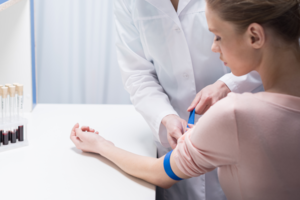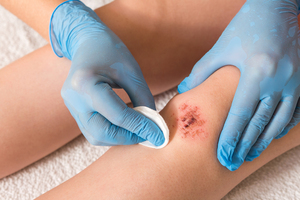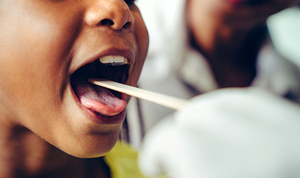Moles, Freckles, and Skin Tag Treatment
Many different types of growths and discolorations can appear on the skin, but according to Cleveland Clinic, most of them are harmless. Moles, freckles, and skin tags are very common and rarely a cause for concern. However, if you have more than 50 moles, new or changing moles, skin that burns easily, or a family history of skin cancer, you should pay special attention to any skin growths and see a dermatologist if you notice anything abnormal, notes the Cleveland Clinic. Monitoring moles and other skin growths can help detect skin cancer early when it is usually easier to treat,.
Moles
According to the Cleveland Clinic, Moles are very common growths on the skin and are usually harmless. Moles can change over time, but should not be painful and should not bleed. If you have a skin mole that hurts or bleeds, the Cleveland Clinic recommends having it examined by a doctor.
What is a mole?
A mole is a growth on the skin that may appear as a black or brown spot, notes Cleveland Clinic. Moles are very common and can appear anywhere on the skin. They are usually non-cancerous, according to the Cleveland Clinic.
Moles typically appear on the skin during childhood and adolescence, and they may change in appearance or fade over time. According to the National Library of Medicine, most adults have anywhere between 10 and 40 moles, so if you see a black mole on your skin, this is usually normal, notes the National Library of Medicine..
What causes a mole?
Moles are caused by clusters of cells known as melanocytes, which are responsible for producing pigment in the skin, reports Harvard Health. Melanocytes are typically spread throughout the skin, but can sometimes grow in clumps, causing a concentrated area of skin pigment.
What causes moles to suddenly appear?
While most moles form in childhood, new moles can also appear during adulthood. Cleveland Clinic notes that you should be suspicious of any new mole that forms after the age of 30. New moles form when melanocytes duplicate, causing clusters of cells. The Cleveland Clinic states that appearance of new moles can be triggered by several different factors as you age, including hormonal changes, reactions to certain drugs or medications, or sun exposure. Women who are pregnant or going through menopause often notice the appearance of new moles reports the Cleveland Clinic.
What are the different types of moles?
According to Cleveland Clinic, moles are categorized into three broad types:
- Common moles are small growths with a distinct edge. They may range in color from your natural skin tone to brown.
- Congenital moles, which appear in about one in 100 people, are moles that are present at birth. Congenital moles are more likely to develop into skin cancer than moles that appear later in life.
- Dysplastic moles, medically known as dysplastic nevi, are irregularly shaped and tend to have uneven color. They may have dark centers with lighter, uneven edges. These moles tend to be hereditary, and people with dysplastic moles tend to have a greater chance of developing skin cancer.
What does a mole look like?
According to the Cleveland Clinic, common moles are usually small and round or oval in shape. They typically have a smooth surface and are evenly colored. Common moles are usually smaller than 5 millimeters wide, or about the width of a pencil eraser.
Dysplastic nevi, also sometimes referred to as atypical moles, look very different from common moles, reports the National Cancer Institute. Dysplastic nevi may be larger, have irregular edges, and contain a mix of colors. Dysplastic moles can also have a scaly or pebbly surface or may have a raised area in the center.
How do I know if a mole is cancerous?
According to the National Cancer Institute, common moles and dysplastic nevi rarely turn into skin cancer. However, if you have more than 50 moles, you have an increased chance of developing skin cancer, reports the National Cancer Institute. Only a doctor can determine if your mole is cancerous, so if you are concerned, you should see a dermatologist. If you have dysplastic nevi, the National Cancer Institute recommends that you check your skin once a month, and see a dermatologist if you notice any of the following changes:
- Changes in color
- Changes in shape or size
- Changes in texture
- A hard or lumpy surface
- Pain or itching
- Bleeding or oozing
How are moles treated?
Most moles do not need to be treated, according to Cleveland Clinic. However, a dermatologist can remove a mole if it’s suspicious or bothersome to the patient. Check with your insurance company before having any moles removed, as the removal of a mole for aesthetic purposes may not be covered.
Removing a mole is typically a simple procedure that can easily be performed in a doctor’s office or clinic. Moles are typically removed in one of two ways, according to the American Academy of Dermatology Association:
- Surgical excision. Your doctor will numb the area and use a scalpel or blade to cut the mole out. Stitches may be required to close the skin.
- Surgical shave. Smaller moles can sometimes be removed by shaving them off with a blade. Stitches usually aren’t required after shaving a mole.
If your doctor believes the mole is suspicious, the tissue will usually be examined for cancer cells.
Never try to remove a mole at home as you could disfigure your skin or cause an infection. If the mole is cancerous, you could risk leaving some cancer cells behind, which could then spread, reports Cleveland Clinic.
Freckles
Freckles are small brown spots on the skin. They appear most often on the face, shoulders, chest, and arms. Freckles are most common in people with lighter skin and light or red hair, according to Cleveland Clinic.
Freckles are harmless and do not need to be treated, notes the Cleveland Clinic.
The difference between a mole and a freckle
Moles and freckles may be similar in appearance, but they differ in some key ways. Freckles are typically clusters of flat spots that are lighter in color, and they may become darker when exposed to the sun. Freckles grow on the superficial layers of skin, whereas moles originate deeper in the skin, notes the Cleveland Clinic.
Moles are generally larger than freckles and may have a slightly raised surface.
Skin tags
Like moles and freckles, skin tags are generally harmless, according to Cleveland Clinic. However, they can be removed by a dermatologist if they are bothersome.
What are skin tags?
According to the Cleveland Clinic, a skin tag is a small flap of tissue hanging off the skin. Skin tags are often found on the neck, chest, back, or armpits, and are more common in women. Skin tags are usually painless, but then can be irritating if they rub against clothing or jewelry.
What causes skin tags?
Skin tags, medically known as acrochordons, form when extra cells are produced in the top layers of the skin, reports Cleveland Clinic. They are more common in areas where the skin naturally rubs against itself, such as in the armpits, under the breasts, or in the genital region.
How are skin tags treated?
According to Cleveland Clinic, most skin tags don’t require treatment, and many will fall off on their own. However, if a skin tag is bothering you, becomes irritated, or bleeds, your doctor can remove it. Skin tags can be removed with a scalpel, can be frozen off with liquid nitrogen, or can be burned off.
Where can I get skin tags removed?
A doctor specializing in dermatology is usually the best option for removing skin tags according to the Cleveland Clinic. Dermatologists are experienced in working with delicate skin tissue, such as the eyelids, and will be able to remove skin tags on the face with minimal scarring. Cancerous skin tags are rare, but in some cases, another type of skin growth can appear as a skin tag. Your doctor will be able to have the tissue examined if it appears suspicious.
Do not attempt to remove skin tags at home, as this can lead to scarring or infection, as advised by the Cleveland Clinic.
To find a qualified dermatologist near you, visit Solv's provider directory. Many of our verified doctors offer same-day or next-day appointments and allow you to book an appointment online instantly.
Find Moles, Freckles, and Skin Tag Treatment near you
- Alabama
- Alaska
- Arizona
- Arkansas
- California
- Colorado
- Connecticut
- Delaware
- Florida
- Georgia
- Hawaii
- Idaho
- Illinois
- Indiana
- Iowa
- Kansas
- Kentucky
- Louisiana
- Maine
- Maryland
- Massachusetts
- Michigan
- Minnesota
- Mississippi
- Missouri
- Montana
- Nebraska
- Nevada
- New Hampshire
- New Jersey
- New Mexico
- New York
- North Carolina
- North Dakota
- Ohio
- Oklahoma
- Oregon
- Pennsylvania
- Rhode Island
- South Carolina
- South Dakota
- Tennessee
- Texas
- Utah
- Vermont
- Virginia
- Washington
- Washington DC
- West Virginia
- Wisconsin
- Wyoming
Moles, Freckles, and Skin Tag Treatment FAQs
Solv has strict sourcing guidelines and relies on peer-reviewed studies, academic research institutions, and medical associations. We avoid using tertiary references.
Everyday Healthcare, Simplified
Expert advice to help you live your best life








